Brian Kershisnik
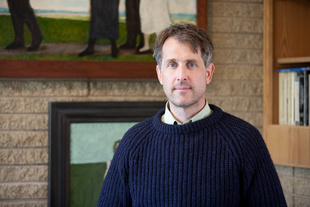
What attracted you to art?
I always drew a lot, but as play, not as a disciplined pursuit. My knowledge and attraction to art was pretty typical, I think, until college. I excelled in my art classes growing up, but it never occurred to me that one could be an artist. I became interested in architecture and decided to get an undergraduate degree in art before a master’s in architecture. Almost at once my world changed, and art it has been ever since.

What about painting?
My initial interest was ceramics and, while at BYU, I met Joe and Lee Bennion. We arranged for me to work in Joe’s Pottery in Spring City for a summer. That summer I learned that I am not a potter. Lee suggested I mess about with her paints in her beautiful studio that was, at that time, in the old schoolhouse. I did a few paintings, all bad, but it was apparent to me that we were on to something.
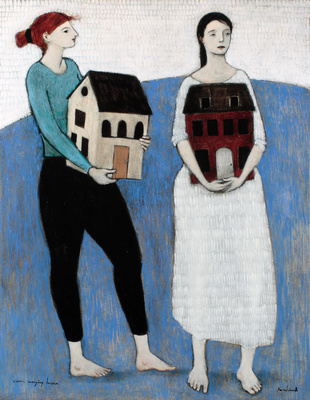
What are your working processes—beginning, middle, end. How do you know when a painting is finished?
Work a lot, try a lot, follow a hunch. My studio is large so it accommodates my working on fifty to a hundred paintings at a time, along with drawings, monotypes, woodcuts. I don’t wait for fully fledged ideas to descend upon me. I look for them with my fingers and my gut. Most ideas are not really that good—at least not good enough yet. They need adjusting and editing so I must give myself something to adjust or edit. I have started many paintings which I never finished, but I have yet to finish a painting which I never started.
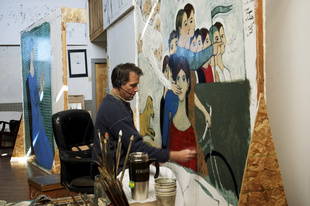
What is your philosophy on making art?
I believe in a cosmos in which art, though vital, is not the most important thing. An external moral compass is critical for the art to participate in the great human drama in a significantly constructive way. That external moral compass is not always obviously quantifiable, or even comforting. It is the sum of what truly is. We humans (at least this one) are horribly imprecise and things that move us any closer to the center of the nature of things are good. If something is truly, authentically true, it is bigger than I am and independent of me. I wade in the shallows finding amazing shells which evidence something much bigger than this present experience. Many of the shells are fragments and shards, but some are complete and fantastic—but only the beginning of real answers. Art would do us all a great deal more good if, rather than criticizing, whining, and bickering, or even attempting to provide the answers, it helped us refine our questions.
What things inspire you?
Right now? Food—bacon, particularly. Paper planes. Always people. My collection of life and death masks.
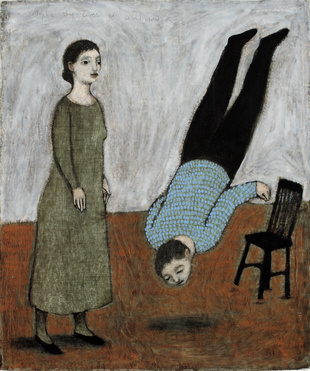
You’ve been making art for a long time. How do you keep things fresh?
Fresh? I think I just work on what feels vital to me. I don’t think about freshness. I don’t think vital things get stale. I don’t always find the vital thing but I am always looking for it. That way I am always at least just a little bit terrified.
How do you balance home and work?
I make no claim to such a balance.
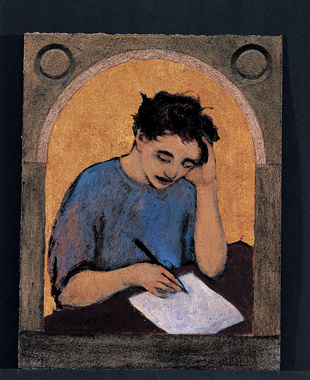
You have a strong connection to motherhood. Could you explain your fascination for us?
No, I can’t explain it. It is too near the core for me. I just don’t fight it.
Your work has a slippery familiarity about it. The images conjure up things that seem almost familiar, maybe forgotten. How do you do that?
They feel that way to me too. That is what I am feeling for, searching for. Why it occurs, I cannot say.
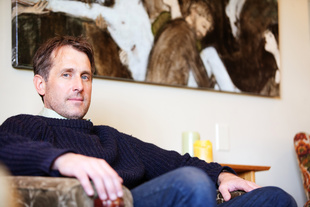
Your work is often very sensitive. How do you keep it from becoming overly sentimental?
I believe myself to be extremely sentimental and a hopeless romantic, but I feel an urgency to not lay it on too thick in my painting. I let those tendencies draw me deeply into an idea, but try to exercise enough wisdom and restraint to not bludgeon my audience. I think in a way it is utilizing a handicap to a useful end.
And, of course, I don’t always get it right. The metaphors perch rather precariously on pretty delicate structures. Occasionally I indulge myself in a reverie of sentiment and sometimes it works. I think the danger lies in the work dictating a specific emotional response. Your emotions are not my toys to manipulate. To do so would be irreverent.
As a musician, how do these art forms work together or against each other?
Different ways to examine and explore similar things. Also, I rest from painting by playing music. They are both performances that require courage and skill. They don’t feel very different to me.
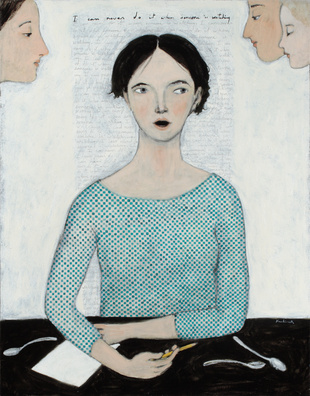
Do you have a favorite art experience you’d like to share?
I had a dream several months ago where I was at my neighbor’s house examining his collection of my paintings (in the waking world he doesn’t have any, but in the dream he had five or six) when we both simultaneously realized that every painting quite serendipitously contained bacon.
Well, I had never painted bacon before, but set my hand to several pieces which do include bacon. I could not remember the images from the dream, but I could remember a few of the titles. I am working on several such pictures now. At the store in Kanosh they sell this wonderful bulk bacon. It has become very important to me. For me it is the only real bacon. It has now worked its way through my dreams, into my work. It doesn’t usually work that way. In fact, it doesn’t usually work any particular way, but hopefully it works.

How has being LDS influenced your work?
Discipleship is a conversation, not an event. It is ongoing and influences everything. I actually choose to let discipleship influence the work as it will, and I don’t set expectations of how they are to work together. I have loved, and been loved by, too many great examples of discipleship to name them. I feel that all of my work is religious—very religious—not because I set out to make religious work, but because I set out to be a religious man.
What reception have you had outside of Utah?
Very good. I believe that more than half of my work leaves Utah. There is no doubt that I have a great base of collectors here, but the response has been positive elsewhere too.
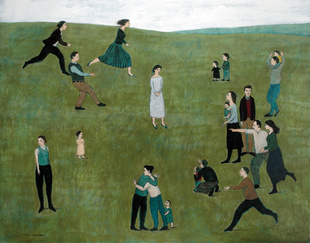
Do people who aren’t LDS have spiritual experiences with your work?
Interestingly, yes. Although I said my work is religious, it is not usually specifically doctrinal and many people respond to it. It is a very human sort of religion in my work and so far, to my knowledge, every collector has been human, and every human is also spiritual, so that shouldn’t be surprising.
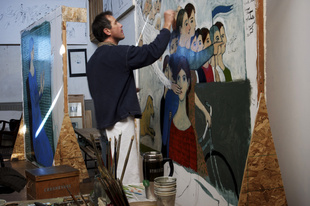
How do you see your work helping build the kingdom?
I believe that if I seek to be good, and true, and honest, and virtuous, and hard working, it will be my privilege to participate in God’s kingdom, but I try to be very careful about not dictating how my contribution will be useful. I have seen artists’ convictions dashed on the rocks of their own inflated notions of usefulness to God’s kingdom. I talk to God all the time. We have a very happy working relationship. ❧
